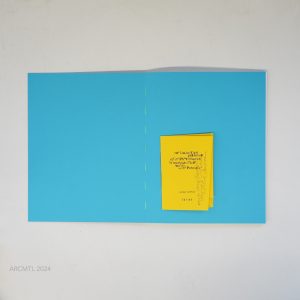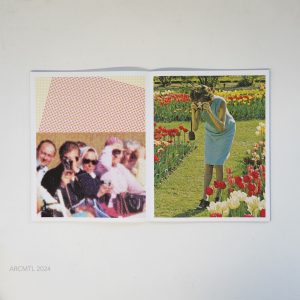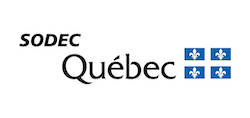Volume 7 MTL: NoRoutine Books with Michel Campeau
In honour of the launch of Michel Campeau’s book The Lilliputian Presence of the Photographer in the Four-Colour World of the Postcard, which was published on October 4th, a discussion was held between the publishers and the artist.
Volume 7 guests of honour, NoRoutine Books is a Lithuanian independent publishing initiative dedicated to the design and printing of unique art books. Their publications are limited to 99 copies, making them rare and precious works for collectors and art lovers. Each book is carefully constructed, combining creativity and craftsmanship, and reflects an innovative approach to contemporary publishing.
Michel Campeau is a Canadian photographer and collector. He is a member of the Groupe d’Action Photographique alongside Claire Beaugrand-Champagne, Gabor Szilasi, Roger Charbonneau and Pierre Gaudard. He is passionate about darkrooms and silver halide printing.
The following is an edited transcript of a conversation held as part of the Volume 7 MTL art book fair and conference, on October 6, 2024 in Montreal.
Vilma Samulionytė: Thank you for having us here. And for Michel, for letting us publish your book the way we wanted, for the freedom you’ve given to us. We met Michel five or six years ago in a beautiful photography festival, Meetings of Gaspésie.
And then, in the beginning of 2020, we invited you to Vilnius to have an exhibition, but quarantine happened. And we could not have you there.
But we [had an] exhibition. It was hanging for a few months and people could look through the windows at the beautiful Campeau Exposition of Darkroom series.
Michel Campeau: The people couldn’t come inside?
Vilma Samulionytė: No. All the art centres and the galleries were closed. But exhibitions were on, you know? You had to do them, because they were planned! They could see the first room and the part of the second room through the arch. And last year, we thought, well, maybe it’s time for Michel to come to Lithuania to present his artistic activity.
Michel Campeau: Last year I took part in the Lithuanian photographers’ conference in Nida, in the north of Lithuania. And I did a presentation there with European artists, most of whom were Lithuanians.
Louis Rastelli: Was it your first time in Lithuania?
Michel Campeau: Absolutely.
Vilma Samulionytė: And I think it’s important to say that NoRoutine Books is a very special publishing platform. This is our 10th anniversary and we have 25 books published. So, sometimes we publish four, sometimes one book per year. All of them are limited edition, 99 copies. Usually they’re numbered, signed with some editions. This one was beautifully made by Gytis Skudzinskas. And since Michel called the book The Lilliputian Presence of Photographer in the Four Color World of the Postcard, so Gytis used four colors present in the printing process: cyan, magenta, yellow, and black – which I think [hits you] first thing when you open the book.
I somehow see this series like a postcard series, but it’s also a sequence of photographers. I probably should give Michel the [floor to] continue about the postcards, how they came to you, where you found them, why, and then how everything all connected here.
Michel Campeau: There are two fundamental things. Firstly, I come from a graphic arts background. So, I’m familiar with the lithographic processes, even though I was a very bad student and never really understood the notion of subtracting or adding colours. And I still don’t.
And it’s worth mentioning that I also had an encounter with the work, or part of the work, of a photographer I admire a lot in Europe, Mathieu Pernot, who had also worked with postcards. […] The first work of his I came across in a shop window in Paris was a book containing these photos, and it was a real shock. He had such a sociological approach to photography. And I think that triggered something in me in terms of my field of interest, which was the material culture of photography. The starting point for all this is darkrooms. Here in Montreal, in Quebec and elsewhere in the world, I’ve been photographing darkrooms with flash. And with a digital camera. I’ve committed blasphemy, I’ve committed an act of sacrilege in the historical sites of photography! From that moment on, I published this work and I’ve always tugged at the thread of this project. I wanted to explore the notion further, to explore what I could create within this idea of the material culture of the darkrooms.
I’m working on a collection of darkroom archives. This is the third time I’ve done a specific project on darkrooms, based on a collection of archives that an insomniac friend finds me on ebay in the middle of the night, or that a friend in France collects for at flea markets and garage sales.
But getting back to postcards, it’s essential to say that I owe this work to a man called Marcel Bienvenue, whom I met at a vintage paper fair and told about the project. He came back to me some time later and said, ‘OK, I’m going to buy a batch of 5,000 postcards’. And then he says two weeks, three weeks, a month later, ‘Oh, I’ve identified about sixty of them with photographers.’
Wow. Okay. That’s how it started. I didn’t find anything! I didn’t find a single postcard the same way I didn’t find a single darkroom photo. That’s other people’s contribution. And the first thing I’m going to do when I leave the salon is to take a copy to Marcel Bienvenue. That goes without saying. Because his work has enriched my work. In fact, I don’t photograph more. I work more on projects that are based on the photographic POV as a theme. I work in immobility from home. I often think to myself, what will be next in my work? The last thing that came to me a few weeks ago was a collection of photographs of donkeys. So now I’m getting into that.
Louis Rastelli: Photos of what?
Michel Campeau: Donkeys! Because one of my books is called The Donkey that Became a Zebra. Darkroom stories. And why’s it called that? Because some friends of ours, they came from Mexico one day and they said to me, “In Tijuana, they disguise donkeys as [zebras], and then they walk tourists around on them!”
As for the [NoRoutine] book, I only first saw it yesterday at noon. It’s true! I was amused and delighted by this invitation, that people could make a book out of my work. I sent off all the postcards and fragments. And I let it go. I trusted them because I’d seen their books and I was familiar with their collections. I liked the idea that a publisher could do something independently of me.
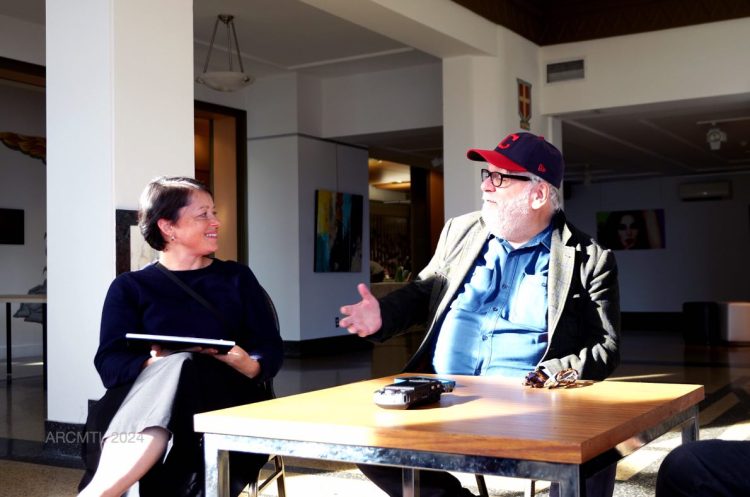
Vilma Samulionytė: Yeah, I told you already in the beginning that we were very thankful [for] that. And Gytis, he really is not afraid of difficult tasks in the books. And you can see how he really took the concept of this four-colour printing, and he cut the yellow booklet with the text. And then he uses the yellow threads for the binding. I think [with] that freedom you gave, he could really go into these details. Sometimes [he would] wake up in the morning and he goes like, “Now I know how I will do that,” you know?
Michel Campeau: But I feel his pleasure. I really feel his pleasure in doing the book.
Vilma Samulionytė: Normally, he is doing the book design, but sometimes when you do a bigger project with a bigger print run, more money involved and so on, lots of people are behind the process. So, sometimes maybe you would like to do things differently. And I think in this publication, or in our NoRoutine books publications, he’s really getting his talent out, you know? It’s quite expensive and challenging. It takes time, but then you are awarded, you know, with a beautiful publication. The postcards will exist now forever, not just scanned and digitalized and somewhere stored.
Michel Campeau: Yeah.
Louis Rastelli: So, it started with a selection you made of the postcards, but also zoomed in fragments. So, you digitized them and then you selected fragments and sent them all?
Vilma Samulionytė: Yeah.
Michel Campeau: In 2019, I had an exhibition at the McCorde Museum and I showed maybe four enlargements of the postcards as inkjet prints. And next to them I put the originals, small photos that I had framed. The idea was to show a bit of the game. Because, fundamentally, my interest was in the fragment. It was the magnitude, to magnify not the pixel, but the frame. 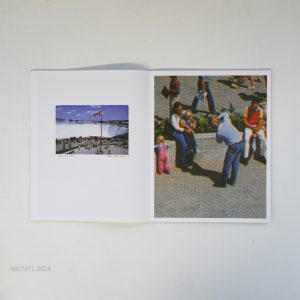
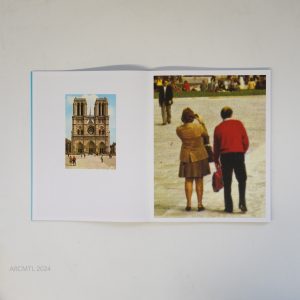
So I received the postcards. I’d look through a magnifying glass, make myself a little frame, crop it, and then I’d work on it as best I could. Then, if it didn’t look right, I’d rescan it to make the fragment. I did all that, then I sent [NoRoutine] everything, all 54 postcards, the 50 fragments. I sent over a short introductory text in which I set out the aims and the origins of the project, the title and a few acknowledgements.
But, the question I want to ask is about the other artists with whom you work. Were they giving their advice?
Vilma Samulionytė: In our publications with the with the publishing platform, we usually, we call it “artist to artist,” like we listen [to] how they imagine things and then we advise, “Maybe like this.” A discussion happens.
And also in the choice, when we choose the projects. Like in the beginning, it was just Lithuanian artists. We know them and we know their project and we really somehow feel that it would look good in the book. And they appreciate that. So, we had no conflict. Somehow, we try to [be] very friendly and listening to all sides of the situation.
Louis Rastelli: But there was no outside other input other than the designer in this case?
Vilma Samulionytė: In this case, Gytis and me, we would discuss them, and then when we had the layout of the block, we sent it to Michel, and Michel was like, “Okay, it looks good.”
Michel Campeau: I never seen that before yesterday.
Vilma Samulionytė: But the inside, I mean, to have the layout of the inside block is one thing. But then, because this was printed in Offset Printing House, sent back to us, you know, with this yellow thread and blue. The cover, the pink thing, was again designed and brought to another shop to do the silkscreen. Before the first copy happened, I [also] didn’t know how that was going to look. I just knew from the words from Gytis. Then the black thing was also bought in the paper shop, cut, you know? And so in the end, all the final results, it never was in one PDF, let’s say, you know, it was done in a studio, finalized.
Louis Rastelli: So were you happy when you saw it?
Michel Campeau: Yeah, absolutely, absolutely. I was happy throughout the whole working process. It’s a gift, I mean, when you offer something from an artist… I liked the idea of playing the game and accepting this constraint of giving them free reign. I’d done my bit; my bit was my work. It was the writing.
Louis Rastelli: Well, that’s a great partnership then I guess in the end.
Vilma Samulionytė: I think so! It was somehow very natural. We liked you! You know, we met you. We had a couple of good conversations and we were like, “This Michel is a really nice person. Maybe we should, you know, look-“
Louis Rastelli: And that was in your 2019 trip?
Vilma Samulionytė: Yeah, yeah, yeah. […] It was somehow good vibes, you know?
Michel Campeau: And also the fact that photographers want to meet publishers! Because it’s very difficult – these are mostly self-published books. The artist’s book, the photo book, is growing by leaps and bounds. There are examples here and everyone is making books. Everyone wants to make books. Everyone is renting tables, trying to sell their books, promote their books, all that, it’s obvious.
So, obviously, it doesn’t happen quite often that a publisher or an editor wants to do something with my work.
Vilma Samulionytė: We have freedom, I think, to do what we would like. And I mean, it took time, you know, to come up with the final idea. Like when we had your exhibition, I thought we could do the catalogue maybe then, but then this quarantine happened. So, it took like four or five years somehow to come up and then to choose from your archive something. But the postcards were, I think, the best choice.
Michel Campeau: I’m going to continue collecting postcards as part of my work. It’s not the core of my work, but I’m going to keep collecting them.


